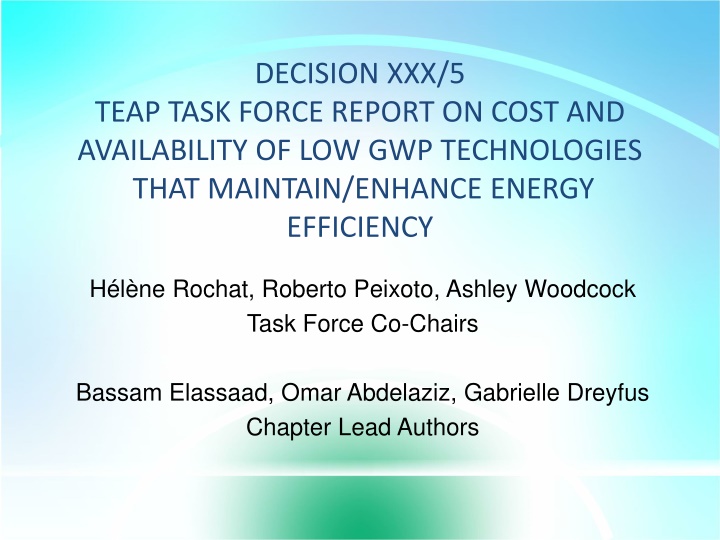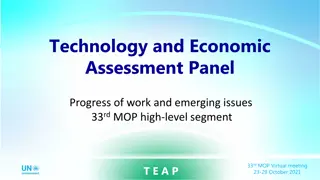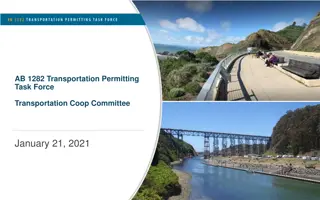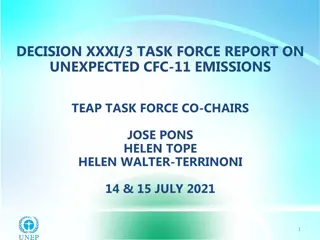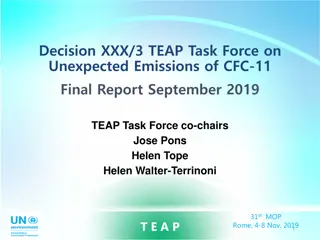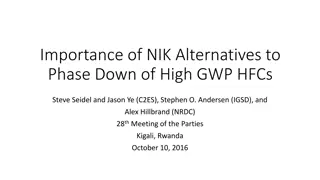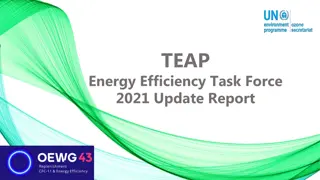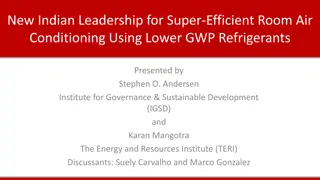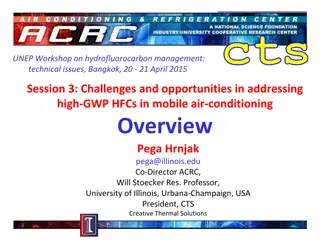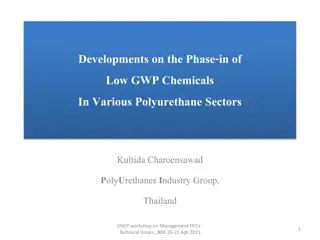TEAP Task Force Report on Low-GWP Technologies' Cost and Availability
Task Force report focusing on the cost and availability of low-GWP technologies maintaining energy efficiency in refrigeration, AC, and heat pump sectors. Includes chapters on technologies, costs, market role, and discussions, providing insights into industry trends. Detailed analysis and predictions on the evolving availability of components, with emphasis on regional variations and future prospects.
Download Presentation

Please find below an Image/Link to download the presentation.
The content on the website is provided AS IS for your information and personal use only. It may not be sold, licensed, or shared on other websites without obtaining consent from the author.If you encounter any issues during the download, it is possible that the publisher has removed the file from their server.
You are allowed to download the files provided on this website for personal or commercial use, subject to the condition that they are used lawfully. All files are the property of their respective owners.
The content on the website is provided AS IS for your information and personal use only. It may not be sold, licensed, or shared on other websites without obtaining consent from the author.
E N D
Presentation Transcript
DECISION XXX/5 TEAP TASK FORCE REPORT ON COST AND AVAILABILITY OF LOW GWP TECHNOLOGIES THAT MAINTAIN/ENHANCE ENERGY EFFICIENCY H l ne Rochat, Roberto Peixoto, Ashley Woodcock Task Force Co-Chairs Bassam Elassaad, Omar Abdelaziz, Gabrielle Dreyfus Chapter Lead Authors
DECISION XXX/5 PARA 3 To request the Technology and Economic Assessment Panel to prepare a report on the cost and availability of low-global- warming-potential technologies and equipment that maintain or enhance energy efficiency, inter alia, covering various refrigeration, air-conditioning and heat-pump sectors, in particular domestic air-conditioning and commercial refrigeration, taking into account geographical regions, including countries with high-ambient-temperature conditions . TEAP agreed to deliver a preliminary report for the OEWG, and a final report for the MOP This final report presentation contains new information in red following parties questions and discussion in OEWG 1
Decision XXX/5 Task Force Co-Chairs H l ne Rochat Roberto Peixoto Ashley Woodcock Members Omar Abdelaziz Jitendra Bhambure IN Suely Carvalho Daniel Colbourne Gabrielle Dreyfus Bassam Elassaad Samir Hamed Herlin Herlianika ID Mary Koban Tingxun Li Bella Maranion Maher Mousa Tetsuji Okada Alaa Olama Fabio Polonara Nihar Shah Rajendra Shende IN JO CH BRA UK US PRC US SA J EG IT IN EG BRA UK US LB 2
Report Structure Chapter 1: Introduction Chapter 2: Availability of low-GWP technologies and equipment that maintain or enhance energy efficiency Chapter 3: Costs of low-GWP technologies and equipment that maintain or enhance energy efficiency Chapter 4: Role of market in the availability of energy- efficient RAC equipment and low-GWP refrigerants Chapter 5: Discussion. 3
Chapter 2 Availability of low-GWP technologies and equipment that maintain or enhance energy efficiency 4
Definitions of availability Widely available From several sources Available From a single source Emerging / R&D Pilot equipment available Not Available Not available in the country The availability of technologies and components is predicted to evolve over time. Tables reflect Regional availability at the present time (Q2 2019). Some Not-in-Kind (NIK) technologies could provide energy savings. (Refer to chapter 12, RTOC report) 5
Regions/ country HCFC High-GWP HFC Medium and low GWP HCFC High-GWP HFC Medium and low GWP 53% of the market is HFC-32 units more weighted towards the higher efficiency tiers Regions Australia & New Zealand Not Available High Energy Efficiency Tier Oceania & PIC Available for import Not Available Japan: "The top runner program" requires weighted average APF higher than the standard value.(for both domestic and commercial ACs) Japan Japan: Not Available Korea: 410A system including ductless, mini-split system and VRF Korea HFC-32 units with inverter China: "The top runner program" requires weighted average APF higher than standard value, about 1% of market China: Both HC-290 and HFC-32 inverter that have higher APF than the standard value are introduced China R-410A locally manufactured mainly inverter type Separated MEPS for inveter and non-inverter HFC-32 units with inverter Separated MEPS for inveter and non-inveter Thailand R-410A locally manufactured in some countries or imported MEPS are not separated for inverter and non- inveter except in Singapore and Indonesia Indonesia, Philippines, and Vietnam: HFC-32 units with inverter South East Asia High Tier Energy Efficiency more than 10% above Minimum MEPS India India: R-410A widely available in inverter 3 to 5 star India: HFC-32 and HC-290 available up to 5 Star Central Asia Available for import Available for import Not Available HFC-32 units are available Research on HC-290 and HFO leads to viable results Saudi G-Mark regulation requires certification for charge limitation of flammable refrigerants for residential applications HAT: High GWP HFCs Could not meet higher efficiency with conventional design, however, MEPS >10%, (EER 12.7 ) can be achieved with microchannel heat exchangers Gulf Cooperation Council HFC-32 and R-454B Accepted in Egypt, manufacturing not started Morocco: HFC-32 inverter is available for import Middle East & North Africa Available as locally manufacured or imported Central Africa R-410A units with inverter HFC-32 units in some markets R-410A units with inverter South Africa: 75% of the market is inverter Southern Africa HFC-32 units in some markets EU: Cent A/C 2-speed, Mini-splits VRF - EU Eco- Design, N. America: Emerging new technology using HFC-32 and HFO blends Mexico: HFC-32 inverter by at least one manufacturer Europe EU: Cent A/C 2-speed, Mini-splits, VRF- Eco-Design N. America: Cent A/C 2-soeed, Mini-splits, VRF with R-410A units North America Central America R-410A avaibale Brazil: HFC-32 inverter available from one manufacturer. A second manufacturerannounced production of HFC-32 by end of 2019 HC-290 expected to be available once MLF projects completed. Other countries: available to import S. America: R-410A both fixed speed and variable speed Brazil: 40-50% of R-410A units are inverter South America 6
Availability of AC Components Higher efficiency/variable speed drive (VSD) compressors are available from more than one source. China production of VSD has doubled in 5 years to 70 million/yr, driven by MEPS in many markets. Heat exchangers are mainly fin and tube type. Smaller tube diameter or micro-channel heat exchangers can: - Improve EE. - reduce the refrigerant charge - enable ACs using medium/low GWP flammable refrigerant to comply with safety standards or have higher capacity Higher EE components are available from more than one source and presently in use in many regions. 7
Self Contained Commercial Refrigeration Equipment (SCCRE) The majority of technical options for improved EE are already in use and are independent of the refrigerant type. EE is mainly determined by equipment design. HCFC and HFC refrigerants are being replaced by hydrocarbon units using HC-600a and HC- 290, CO2, and HFO blends Transcritical CO2 systems can improve EE in specific applications 8
Impact of Ambient Temperature on Availability Equipment design for HAT countries requires special consideration in terms of selection of materials and components, especially compressors. VSDs still effective at HAT even with low daily temperature variation PRAHA-I * (2015) tested refrigerants in non-optimised units. PRAHA-II (November 2019) tested refrigerants in optimised units (compressors and other components) and showed improvement in EE at the high ambient test condition (46 C) *Promoting low global warming potential Refrigerants for Air conditioning sectors in High Ambient temperature countries 9
Commercial Refrigeration and Air Conditioning: Availability of technology for enhanced Energy Efficiency - Conclusion Medium and low GWP refrigerants for EE appliances are being introduced in many markets Medium and low GWP refrigerant-based CR and ACs are available in many markets In the case of CR, HCFCs and HFCs are being replaced with low GWP refrigerants 10
Chapter 3 Costs of low-GWP technologies and equipment that maintain or enhance energy efficiency 11
General Consideration regarding EE Low- GWP Technology Costs The TF has identified additional capital and operating costs to convert manufacturing lines: to accommodate flammable low-GWP refrigerants for ACs to include EE design improvements Production at scale reduces the cost of higher EE The relative cost of refrigerants is very small compared to the overall manufacturing costs 12
Capital Costs for converting production line to lower GWP flammable RAC with higher EE O(100 000 units/year) Conversion measure (USD) Minimum Maximum Production line 80,000 165,000 Tooling for smaller tube diameter or establishment of new MCHX production lines (can be used in R410A and HFC-32) 1,000,000 1,500,000 Manufacturing Safety measures 30,000 50,000 Testing 100,000 150,000 Software 0 50,000 Building prototype(s) to verify performance and validate the software 10,000 20,000 IP costs variable variable Shipping 3% 5% Handling 38,000 65,000 Installation 20,000 35,000 Total for production line without heat exchanger changes or shipping 300,000 535,000 Total for production line with heat exchanger changes (excluding shipping) 1,300,000 2,035,000 licensing: royalty (in licensing) or a one-off license payment (A2L vs. A3) 13
Availability and Cost of EE Components for Low GWP RAC Available today? Presently in use? Potential improvement Increased cost per RAC unit Component Variable speed driven 20% to 30% 20% Two stage compression L 10% 10% 20% EC fan motors 7% to 15% 15% to 25% Electronic expansion valves L 15% to 20% 15% Microchannel condenser coil* 15% 0 - negative Smaller diameter condenser 10% to 40% 0 - negative Smaller diameter evaporator 10% to 40% 0 - negative Adiabatic condensers L 25% to 30% 20% to 35% Reducing head pressure 2 3% per 1 K various L = limited; = applicable Percentage improvements are not additives *Microchannel heat exchanger significantly reduces the refrigerant charge ( 40%) 14
Life Cycle Costs (LCC) for Policymaking The assessment of life cycle costs is complex and time- consuming Policymakers promote technologies providing cost savings to consumers over the equipment s lifetime Mainly used in the USA and in the EU Similar methodologies have also been used to a more limited degree to support EE policy making in countries such as India, China, Ghana, Mexico 15
The relationship between efficiency and cost for different EE design options for CR Daily Energy, kWh/day Prod. Cost, $ Man. Selling Price, $ Level Design Option Added Above the Baseline AD1 34.68 2,681 3,869 Baseline AD2 33.59 2,689 3,881 AD1 + Permanent Split Cap. Evap. Fan Motor AD3 28.79 2,731 3,940 AD2 + LED Lighting AD4 27.46 2,749 3,965 AD3 + Brushless DC Evap. Fan Motor AD5 19.41 2,864 4,129 AD4 + High-Performance Door AD6 18.43 2,929 4,221 AD5 + Enhanced-UA Condenser Coil AD7 18.23 2,943 4,241 AD6 + Brushless DC Cond. Fan Motor AD8 17.31 3,033 4,369 AD7 + LED Lighting with Occupancy Sensors AD9 17.16 3,051 4,395 AD8 + High-Eff Reciprocating Compressor 16
US DOE Life Cycle Cost Analyses for CR Mean Values (2012 USD) Life-Cycle Cost Savings Annual Energy Use kWh/yr Median Payback Period, years Net Benefit to consumers % EE Level Annual Operating Cost Average LCC Savings Installed Cost LCC 1 10,022 6,498 1,270 19,135 2,503 89.9 0.5 2 6,727 6,799 970 16,433 5,200 89.9 0.8 3 6,654 6,822 964 16,397 4,709 100 0.8 4 6,318 6,974 921 16,110 4,996 100 1.0 5 6,262 7,003 917 16,105 5,001 100 1.1 6 6,174 7,073 913 16,127 4,979 99.9 1.2 7 5,857 8,909 948 18,294 2,812 89.2 4.7 17
Chapter 4 Role of market in the availability of energy-efficient RAC equipment and low- GWP refrigerants 18
Policies shape markets There is a strong correlation between EE policies and market dominance of inefficient and HCFC-22 AC equipment HFC 25% HCFC 75% HFC 100% HCFC 0% HFC 100% HCFC 0% HFC 84% HCFC 16% HFC 73% HCFC 23% Japan, North America & Oceania Europe China Asia (exc. China and Japan) Middle East, Latin America & Africa HCFC Fixed speed AC Variable speed AC HFC 19
Price is not well correlated with energy efficiency Characteristics that are irrelevant for EE, influence the retail price to a greater degree than the declared energy performance 1 ton FSD room ACs in Brazil 1 ton VSD room ACs in China 2000 14000 12000 1800 10000 1600 Retail Price (RMB) Retail Price (BRL) 8000 1400 6000 1200 4000 1000 2000 800 0 2.50 3.00 3.50 4.00 4.50 2.50 3.00 3.50 4.00 4.50 5.00 5.50 EER (W/W) SEER (W/W) 20
Price trends over time Examples from India, Japan, South Korea and US (TEAP 2018) show trends of decreasing inflation- adjusted prices for AC equipment as efficiency has increased and ODS have been phased out. The reasons for this trend are complex, including: technological innovations and manufacturing efficiencies macroeconomic factors related to manufacturing and commodity price trends. This trend is expected to continue for the HFC phase-down as countries implement national policies and bans. 21
MEPS and other national policies During the HFC phase-down, EE would be improved by: improving national regulations such as MEPS increasing market incentives and servicing capacity and training promoting financial support for local industry in A5 parties for access to capital cost conversion of manufacturing lines, know-how, and IP among others. A5 parties using HCFC technologies, and with low EE or no MEPS regulations, have the greatest window of opportunity to improve the EE of equipment. 22
Benefits of international cooperation in the refrigerant & EE transition Global experience in regional and institutional cooperation has demonstrated benefits in speed, scale, spending, and sustainability that could be applicable to improving EE during HFC phase-down (e.g. Regional Networks of OzonAction, PRAHA, prior-informed consent, etc.). The adoption of common standards for testing and rating methods between markets would enable manufacturers to capitalize on scale and accelerate technology readiness. International cooperation and the development of similar metrics enable monitoring of the market, which allows an easy comparison of products in different geographic regions with similar conditions. 23
Enabling environment for market development (1) Manufacturers respond to policies that promote EE and refrigeration transition by investing in related R&D The adoption of common standards between similar markets would enable manufacturers to capitalize on scale and accelerate technology readiness Transition toward lower-GWP and higher EE AC equipment can happen simultaneously at lower overall cost through: encouraging R&D for new solutions market transformation mechanisms such as bulk procurement, mandatory labelling, early replacement and proper disposal and consumer awareness programs utility obligation programmes regional and international cooperation, and partnerships. 24
Enabling environment for market development (2) While efficiency requirements alone can facilitate the phase-out of HCFC-22, complementary policies, safety standards and market transformation programs are needed to encourage the transition away from high-GWP HFCs. To avoid dumping of inefficient products, some A5 parties may need assistance to develop MEPS, labelling programmes and capacity building, import controls or market transformation programs such as bulk procurement. 25
Summary (1) The Energy Efficiency Task Force has made a detailed assessment of the availability and cost of AC and CR equipment and its components The technologies to enhance EE of AC and CR equipment during HFC phase-down are available The Task Force has identified additional capital and operating costs for conversion to medium and low GWP refrigerants with higher energy efficiency 26
Summary (2) Countries can use market policies and incentives to drive up EE during the phasing down of high-GWP HFCs in CR and ACs: This principle applies to other RACHP sectors This will bring environmental and economic benefits. The transition to lower GWP technologies is evolving rapidly; in some countries it has already happened, with markets transitioning to high EE technologies at the same time International and regional cooperation will be important for market transformation A5 Parties could benefit from: Capacity building, institutional framework to manage the new technologies, energy efficiency compliance, etc. Support for market transformation including MEPS and/or labelling, early replacement, consumer awareness Collaborative efforts to facilitate simultaneous improvement of EE, during the transition towards lower GWP 27
THANK YOU 28
